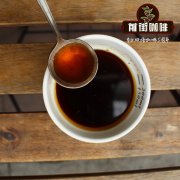What are the characteristics of sun-treated coffee beans in India-Alecon Farm?
What are the characteristics of sun-treated coffee beans in Alecon Farm, a Budan producing area in India?

Coffee was brought into the establishment of the first coffee farm by pilgrims as early as the 16th century, and you might not have imagined that India produces much more coffee than Ethiopia and any Central American country, with 900000 hectares of land growing coffee beans. There are about 140000 coffee farms in India. More than 90% of the farms cover an area of less than 10 mu for small-scale farming. These farms are distributed in the coastal mountains of 900 to 1200 meters in the south and east. Arabica accounts for two-thirds of the coffee varieties, and the rest is Robsta, with a total output of about 440.45 million bags, making it the fifth largest coffee producer in the world.
.
When it comes to Malabar, the most common wind stain in Indian coffee, the main reason is that in ancient times, coffee took months to reach Europe. During the voyage, due to exposure to salt-filled sea breeze and moisture, the coffee beans changed a special taste, and the original fresh dark green coffee beans also became yellowish brown with Mantenin. At that time, Europeans liked this rich thickness and peculiar flavor, but today coffee farmers are beginning to find ways to replicate this flavor. it took them six weeks to expose their coffee to the monsoon monsoon season from May to June, when the southwest sea breeze was strongest, so it was also known as the monsoon Malaba, which made the coffee look a little like an aged manning, with a unique taste with a strong pickled flavor. As for the quality of the coffee, it varies greatly in Taiwan.
Indian coffee is harvested from November to March of the following year. In 2010, Direct Coffee was introduced into Yelnoorkhan Estate Farm (Yelnoorkhan Estate), a Baba Budan producing area in western India at an altitude of 6000 feet. Alecon Farm is rich in natural ecology. Coffee grows in shaded and fertile soil, and there are many species on a farm of 1450 acres, most of which are Kent trees (which are derived from Arabica). Moreover, it is the most primitive and naturally grown coffee farm in India over the past decade, and it is also the most famous area in India for producing sun beans, which is very different from the monsoon beans on the southern and eastern coastal mountains mentioned above, with much more complex aroma and taste.
Light roasting end (City): during shallow roasting, the dried aroma of the ground coffee has a strong grape fruit aroma, the brewed sun beans have the unique fermented flavor of guava, the taste of thin fermented tea is heavy, the acidity of grapefruit is a little low, and tomatoes? The fruit of guava is sweet, while Yuyun slightly sweet oolong tea attaches equal importance to both sweetness and tea feeling.
Indian sun-dried beans and Haramoka sun-dried beans
The beans are similar in shape, same size and little difference in color, but about 4% of the yellowish brown overfermented beans are found in Indian sun beans.
This is the yellowish brown overfermented Indian sun beans, the source of the aroma of beer chocolate in the heavy baking of Indian sun beans.
The aroma is so special that not every friend likes it, but I think those who like sun beans must find it challenging.
Re-baking second burst start (Full City): 1 minute after the first explosion is the heaviest roasting degree of Alecon sun-dried beans, the aroma of coffee grinds seems to have added beer to chocolate, this mixed aroma is very special for Indian sun-dried beans, which are unique to other sun-dried beans, with light star anise after brewing. Spicy licorice, tropical fruit bananas? The sweetness of guava is rich and smooth on the palate. The sweetness of sugarcane brown sugar in the aftertaste is vaguely smelled to the aroma of grapefruit-wrapped tea.
Overall comment: Indian coffee has no prominent or representative coffee farm and flavor trend in the market. It gives the world the impression that balanced, mild and low-acid coffee is suitable for formula coffee, but Alecon Farm offers another different option. complex unstable and stimulating taste and overripe fermented smell full of earthy and special fruit wine vinegar It seems to be full of defects, but like Yasopiaha Mocha, I face you and tell you that this is the most primitive and rough sun-dried bean.
Important Notice :
前街咖啡 FrontStreet Coffee has moved to new addredd:
FrontStreet Coffee Address: 315,Donghua East Road,GuangZhou
Tel:020 38364473
- Prev

Indonesia Surawesi-Toraja Bina lestari Coffee Mandning?
Indonesia Sulawesi-Toraja Bina lestari Coffee Indonesia is the largest archipelago country in the world. Arabica coffee cultivation was introduced as early as the 18th century during Dutch rule. The most important producing area is located in Sumatra Island. Java and Sulawesi islands, produced mantenin deep? The low acidity and rich taste make people call it "the most important coffee in the world".
- Next

What are the characteristics of Yemeni mocha coffee beans? What's so special about the planting history and environment?
What are the characteristics of Yemeni mocha coffee beans? What's so special about the planting history and environment? Where is the flavor going? As a matter of fact, Yemen is located on the Arabian Peninsula of the Asian continent, but it is very close to Africa as long as it crosses the Red Sea and the Gulf of Aden. However, other Arab countries do not produce coffee, so the world classifies Yemen Coffee as a member of the North African coffee family.
Related
- Detailed explanation of Jadeite planting Land in Panamanian Jadeite Manor introduction to the grading system of Jadeite competitive bidding, Red bid, Green bid and Rose Summer
- Story of Coffee planting in Brenka region of Costa Rica Stonehenge Manor anaerobic heavy honey treatment of flavor mouth
- What's on the barrel of Blue Mountain Coffee beans?
- Can American coffee also pull flowers? How to use hot American style to pull out a good-looking pattern?
- Can you make a cold extract with coffee beans? What is the right proportion for cold-extracted coffee formula?
- Indonesian PWN Gold Mandrine Coffee Origin Features Flavor How to Chong? Mandolin coffee is American.
- A brief introduction to the flavor characteristics of Brazilian yellow bourbon coffee beans
- What is the effect of different water quality on the flavor of cold-extracted coffee? What kind of water is best for brewing coffee?
- Why do you think of Rose Summer whenever you mention Panamanian coffee?
- Introduction to the characteristics of authentic blue mountain coffee bean producing areas? What is the CIB Coffee Authority in Jamaica?

